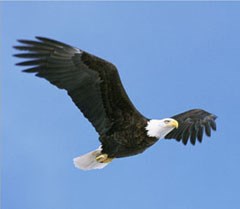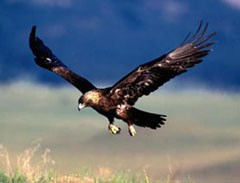
Bald eagles (Haliaeetus leucocephalus) and golden eagles (Aquila chrysaetos) are found in Glen Canyon National Recreation Area (NRA) at various times of the year. These raptors, or birds of prey, are both called eagles though they are not closely related. Raptors are top predators and are crucial to understanding ecosystems. Changes in an eagle population could indicate a change in the availability of prey, which includes mammals, birds, amphibians, reptiles, and insects. Though these birds have different habitat and food preferences, both use the diverse landscape of the Glen Canyon area. 
Bald eagles are usually found near open water and rivers. They feed mainly on fish and waterfowl. Bald eagles are opportunistic feeders and will congregate where prey availability is high. They prefer easy prey such as dying or dead fish, and will often steal prey from other eagles, birds, or mammals. Juveniles, which can be confused with golden eagles, have white scattered throughout their body until they are about five years old when they get their distinctive white head and tail. Bald eagles were listed as endangered in 1978 under the Endangered Species Act (ESA) because of sharp population declines due to pesticide poisoning (DDT), hunting, and habitat destruction. Protection of habitat under the ESA, release of hand-reared eagles, and ban of DDT increased populations of bald eagles. In 1995, the bald eagle was downlisted from an endangered species to a threatened species. On June 28, 2007, the U.S. Fish and Wildlife Service announced the removal of the bald eagle from the threatened and endangered species list. 
NPS 

Interestingly, the golden eagle was the first bird to be considered as a candidate for the national symbol of the United States. Since this eagle is also found in Europe, it was rejected and the bald eagle, native to North America, was approved in 1782 as our national symbol. Ben Franklin famously opposed the adoption of the bald eagle, which he called a “bird of bad moral character” for its scavenging habits. Franklin was an adamant supporter of the turkey (Meleagris gallopavo) as our symbol, which he described as “a little vain and silly,” but a “bird of courage.” Continued monitoring of bald eagles and golden eagles can help detect population trends and contribute to the protection and preservation of these magnificent birds of prey. Published 8/07 |
Last updated: August 14, 2023
